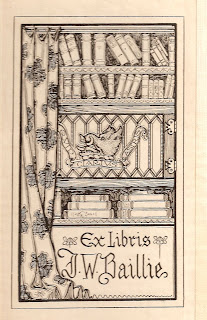With the book fairs in full swing this month there's plenty of opportunity to add new bookplates to the collection, and I find that with all the activity going on I tend switch from research/learning mode over to hunting/acquiring mode. So far the hunting has been good, so I thought I'd just share a sample of some recent finds with you, in no particular order or organization.

One of the nicest ex libris I found was this attractive pictorial to J.W. Ballie. I have a feeling it's a British bookplate, not Canadian, but I suppose one can always hope. Preliminary research hasn't turned up any biographical details, but there appears to be a distinctive artist mark in the lower left corner of the bookplate. Anyone have any idea who the artist could be?
The next bookplate is a nice little late Victorian/early Edwardian era label for Allan Turner of Brockville, Ontario. Similarly, I did a quick search on him and turned up a few interesting facts. An entrepreneur, his father settled in Brockville around the 1850s and was later involved in the development for waterworks and
rail interests for the city, and also appears to at one time have been involved in a
Supreme Court of Canada case concerning imports and exports. Allan himself appears to have taken a medical education and at one time operated the chemist and druggist shop on Brockville's main street.
 |
| Railways, Waterworks, and Medicine |
I noted that the Turner bookplate was not listed in either the Prescott catalogue or the Masson collection, which gives me some hope that there are other equally attractive pre-1900 Canadian bookplates out there beyond the armourial plates that seem to dominate the period. This was a good little find.
 |
| The military bookshelf |
The next bookplate was a bit easier to identify. Lieutenant Colonel Daniel W.B. Spry was born in Toronto and worked in the newspaper industry prior to the First World War. He raised the 54th Kent Regiment at Chatham, Ontario, and served with distinction overseas on the western front. After the war he was appointed as the assistant adjutant quartermaster general in the Canadian militia, and later on served as the General Officer Commanding Military District No.13 (Calgary). He retired at the rank of Major General and was appointed an Officer of the Order of the British Empire. His son, also named
Dan Spry, was also a distinguished officer who led the Royal Canadian Regiment and afterwards the 1st Canadian Infantry Brigade in Italy during the Second World War.
Spry's bookplate is a simple pictorial of a busy bookshelf, again an attractive turn of the century ex libris not listed in Prescott or Masson. I'm wondering since he was promoted, if perhaps there's not another bookplate out there named to this gentleman.
Next up are a couple of bookplates belonging to the Macmillan publishers. As an editor who receives books for review from publishers, I enjoy finding these vintage bookplates. Today, most publishers either simply stick an insert into the review book or worse, staple their business card to the title page. I wish they'd go back to using labels like these.

These labels are clearly intended to just pass on instructions, but I find the one on the right interesting as it provides a wealth of little details about how Macmillan promoted their books to various markets. These bookplates were found in a small book of poetry, which I must say wasn't very good, so maybe that was why they were pushing it out "with their compliments".
There are more odds and ends sitting here in the pile, but I'll save these for another time, perhaps tomorrow if I get the chance. Now to get some cataloguing done.

























